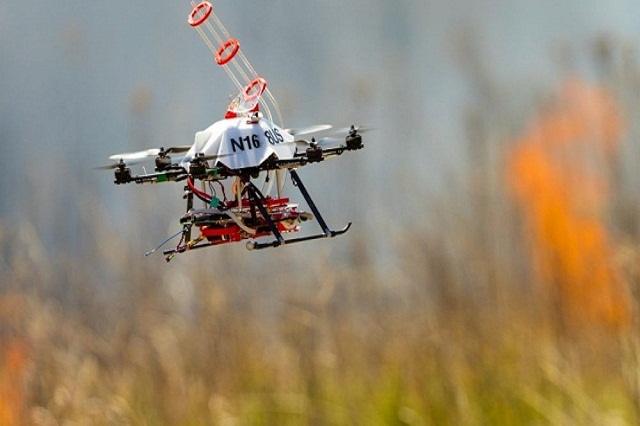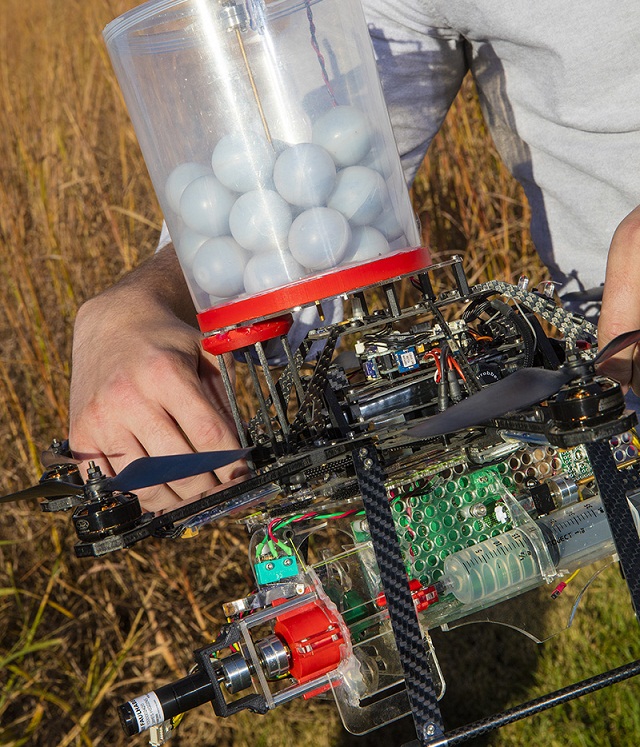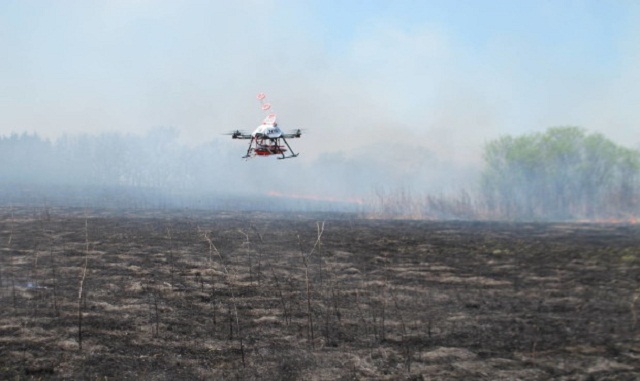
Scientists in Nebraska discovered that drones can eradicate fire and made from this discovery a new tool that can help firefighters.
A team of experts from University of Nebraska flew a drone over prairie at Homestead National Monument, dropping ping pong–like balls with chemical mixture inside that could eradicate grass fires.
Federal officials have shown great interest in this technology because it can help clear unwanted vegetation in hard-to-reach terrain, said Michael Johnson.
Scroll down for video

Chemical powder (potassium permanganate) is filled in these balls before they are uploaded in drone. When drone reaches its destination, it pierces the ball and injects it with a chemical (Glycol) before releasing. This mixture is capable of igniting within a minute or two. This new technology is already being used by helicopters to control burns, but scientists found that drones are much cheaper and can be deployed on a large scale.
How Drones Can Eradicate Fire
Carrick Detweiler, member of research team, said, “You could afford one of these on the back of your fire truck, whereas you probably can’t afford to have a full-sized helicopter parked at your fire station.”
The drone, which is two feet wide, is programmed to drop balls in a pattern to control spread fire. Last week, this new drone rose out of ground and hummed toward its destination through smoky haze. Within minutes, it released balls, sparking like series of small fires, merging into one.
Scientists are hoping that this technology will be able to control fires in hard-to-reach areas, clearing small trees and making it difficult for fire to spread further in an area.

This new drone is fourth one created by the university’s intelligent mobile systems laboratory. It can carry up to 13 balls at a time and drop them from 65 feet in air. The drone is capable of carrying one pound of cargo.
Based on the software that they used, the drone developed by research team costs between $6000 and $8000, said an engineering student who was part of the research project. Similar kind of projects are going on in universities of Colorado, Switzerland, and Pennsylvania.
How researchers were able to make it?
Higgins said that there were many ups and downs in earlier tests. Balls weren’t exploding where they wanted them to. And sometimes balls were exploding before the drone could even release them. Wind factor can’t be left out when flying something in the air. A lightweight drone can’t work in high winds.
Sebastian Elbaun, a computer science and engineering professor, said that firefighters can use drones to gather information and find hot spots as to how drones can eradicate fire.
Elbaum explained, “Today, firefighters have maybe a shovel, maybe their gloves, and their helmets. Imagine them having this in their backpack, pulling it out and telling it, ‘Hey, go scout out there. Check whether it’s hot. Check whether it’s safe.’”

This project started two years ago to find new methods to prevent wildfires in parts of Nebraska. There were about 1,570 wildfires in 2012 in Nebraska, which burned more than 786 square miles. This is even more expanse than the size of Omaha. In 2012, combined cost for ground and air assistance cost more than $11 million.
Researchers will use the results of tests to find out how firefighters can use drones in near future, said Brittany Duncan, assistant professor working with the research team.